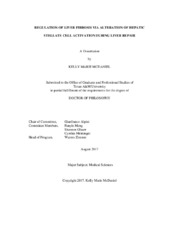| dc.description.abstract | Cholestatic liver diseases including primary biliary cholangitis (PBC), primary sclerosing cholangitis (PSC) and alcoholic-induced hepatobiliary damage are growing problems in the United States as well as worldwide. There are no successful treatments for these diseases that ultimately develop into cirrhosis and end stage liver diseases with no treatment but liver transplantation. We used the cholestatic bile-duct ligated (BDL) mouse liver to examine treatment with small or large cholangiocytes, a mouse model that mimics some features of PSC to study treatment with stem cell-derived extracellular vesicles and a mouse model of alcoholic liver disease to show the important role of let-7. After treatment, liver tissues/cells were analyzed for fibrosis, inflammation, endodermal markers and hepatic stellate cell activation. Mechanisms of action were evaluated further in vitro through the use of hepatic cell lines. We showed that small cholangiocyte treatment reduced fibrosis, biliary mass and stellate cell activation through enhanced expression of FoxA2. We additionally showed that treatment of cultured human stellate cell lines with cholangiocyte supernatants from small cholangiocyte-treated BDL mice showed increased senescence and decreased fibrosis and inflammation. Stem cell-derived extracellular vesicle treatment reduced fibrosis, biliary mass and inflammation while increasing FoxA2 gene expression. Treatment of stellate cells with medium from cultured cholangiocytes treated with stem cell-derived extracellular vesicles decreased inflammatory and fibrosis markers and increased senescence. We further showed that knockdown of Lin28 in mice, increased let-7 expression, reduced fibrosis and steatosis and reduced mesenchymal markers in stellate cells but increased senescence. Taken together, these studies show that successful treatments can reduce fibrosis through alteration of stellate cell activation. These studies may provide important insights into future treatment options for cholestatic and alcoholic liver disease patients. | en |


